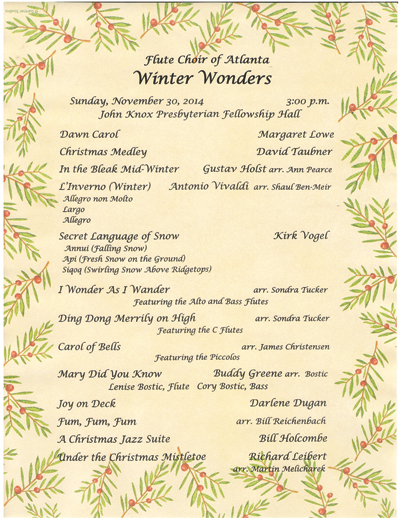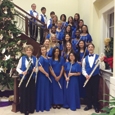Fairbanks Flutists, Fairbanks, Alaska
Director: Dorli McWayne
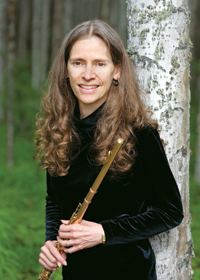 Dorli McWayne has been playing and teaching flute in Alaska for 40 years. She is principal flute of the Fairbanks Symphony and Arctic Chamber Orchestras and teaches at the University of Alaska Fairbanks and privately. In 1981 she founded the Fairbanks Flutists and continues to serve as the director. The flute choir has performed at the National Flute Association Conventions in Las Vegas and Pittsburgh. The highlight of the Las Vegas convention was being televised as background music for the local TV station’s weather forecast. We played The Secret Language of Snow while 108 degree weather was being predicted. In her spare time, McWayne gardens, runs competitively, and shovels snow.
Dorli McWayne has been playing and teaching flute in Alaska for 40 years. She is principal flute of the Fairbanks Symphony and Arctic Chamber Orchestras and teaches at the University of Alaska Fairbanks and privately. In 1981 she founded the Fairbanks Flutists and continues to serve as the director. The flute choir has performed at the National Flute Association Conventions in Las Vegas and Pittsburgh. The highlight of the Las Vegas convention was being televised as background music for the local TV station’s weather forecast. We played The Secret Language of Snow while 108 degree weather was being predicted. In her spare time, McWayne gardens, runs competitively, and shovels snow.
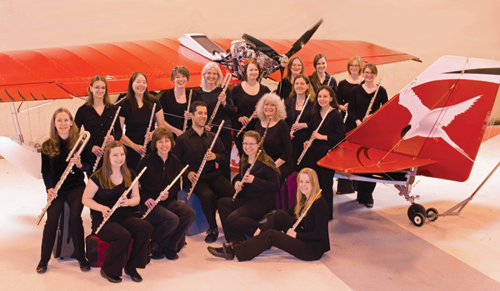
Fairbanks Flutists has 15-20 members ages 18-68. It includes university students, Fairbanks Symphony flutists, and community members. Each year we present one concert and usually have seven rehearsals. Fairbanks Flutists members have been performing together for 35 years. During this time we have amassed a large library of music. Sometimes I plan the program around a new piece and then dip into the repertoire from past performances to fill out the program. In May 2014 we ended the concert with the final movement of Flutes on Vacation by Jacques Casterede and wanted to play the entire work in 2015. This decision instantly gave us the title and theme for the May 2015 concert. This musical vacation took the listeners to five countries with works either depicting a specific country or native folk songs as in the case of Loch Lomond by Ervin Monroe and The Sea in Spring by Michio Miyagi.
The audience loved these geographically different pieces, and they were also technically challenging for the players. The program included both original flute choir works and arrangements. I added two bass flute parts to The Sea in Spring to create more of a shakuhachi effect. This also gave the alto and bass players more to do than usual. Flutes on Vacation was originally written for flute quartet, so the challenge was to get 20 flutes to sound like four. To further carry the theme, the conductor can give a brief description to the audience. We also had fun taking a photograph of the group in front of a friend’s home-built plane and used this for publicity.
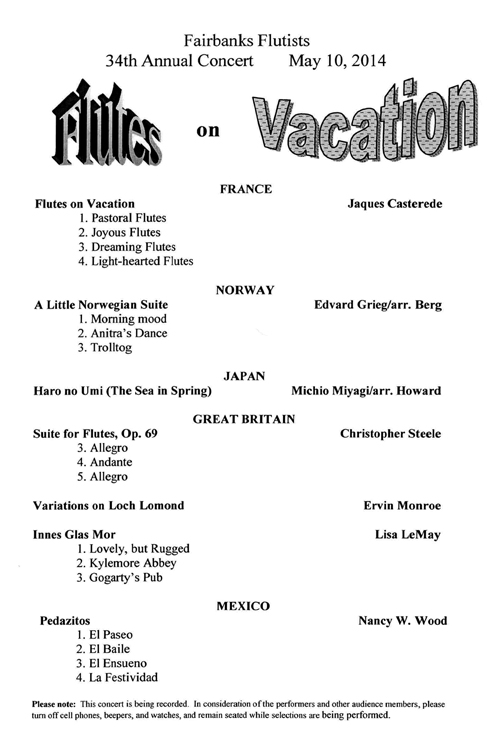
Illinois Valley Flute Ensemble, LaSalle-Peru
Director: Sue Gillio
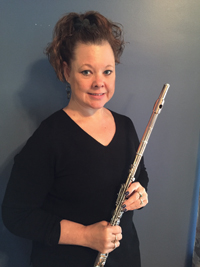 Sue Gillio, flute professor at Illinois Valley Community College, is the owner of Music Suite 408 and director of the Illinois Valley Flute Ensemble. Gillio is a graduate of Western Illinois University (BA, MA, Gerald Carey) and is principal flute of the Illinois Valley Symphony. She also teaches at the Summer Flute Camps in San Diego and Westminster Choir Conservatory in Princeton, New Jersey.
Sue Gillio, flute professor at Illinois Valley Community College, is the owner of Music Suite 408 and director of the Illinois Valley Flute Ensemble. Gillio is a graduate of Western Illinois University (BA, MA, Gerald Carey) and is principal flute of the Illinois Valley Symphony. She also teaches at the Summer Flute Camps in San Diego and Westminster Choir Conservatory in Princeton, New Jersey.
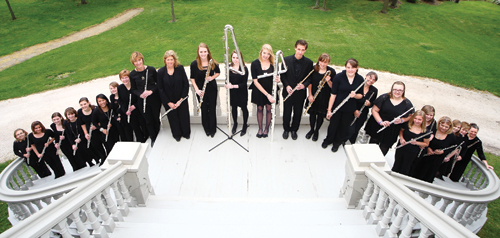
The Illinois Valley Flute Ensemble has 28-30 members from 9th grade through adult. They usually present five public concerts plus church services and holiday-themed concert appearances and rehearse weekly.
We enjoyed this Halloween program from 2012 which we played for a packed house. Since many people do not realize the music heard on soundtracks for television shows, commercials, and cartoons is classical music, this program highlighted the concept that classical music can be fun. It was an effort to educate the audience in an enjoyable way. We performed at night lit by LED candles and dressed in bat capes and other costumes.
I pick music based on a theme for a program, but I do not select a program based on key relationships. I like to begin the concerts with something upbeat or “Fanfare-ish” such as the opening of Richard Strauss Also Sprach Zarathustra, Op. 30. I enjoy programming classical music that the audience and the players may associate with other things such as TV commercials, cartoons, or a movie soundtrack so that there can be an educational component to the concert. Since the audience is there to listen to music, I speak very little during concerts. For the Halloween concert we had a large number of children in the audience so I programmed the sound track to the Addams Family television show so they could snap their fingers along with us.
While Phyllis Avidan Louke’s Of Wizards and Witches and the “Chrysalis” movement from Suite Butterfly were not well-known to the audience, they are programmatic and created musical pictures in the audience’s imagination. I also try to select music that the flutists enjoy practicing and the audience will enjoy hearing.
Another of my favorite programs included a performance of Louke’s Temple of Heaven. One of our adult flutists had just returned from a trip to China and we created a PowerPoint presentation of her photos which were shown during the performance. I like combining the visual and performing arts together in a creative way.
I am currently planning a Flute Madrigal Dinner for a Christmas concert, a concert featuring Bugs Bunny/Cartoon music, and a Starved Rock State Park/Illinois-Michigan Canal themed program since we are based in the Starved Rock Illinois Valley. Most of our programs are 50 to 60 minutes of music in length. It is better to have the audience wanting to return to hear us play.
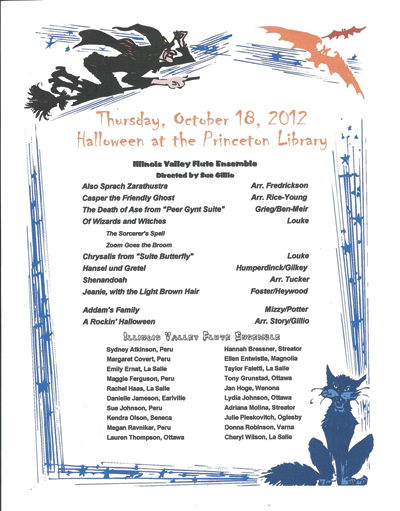
Rose City Flute Choir, Portland, Oregon
Director: Phyllis Avidan Louke
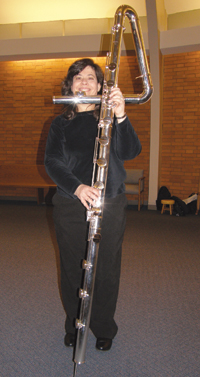 Phyllis Avidan Louke has played in flute choirs since 1971, and has served as Music Director of Rose City Flute Choir since 1996. She has conducted the Professional Flute Choir (2004) and the High School Flute Choir (2002) at NFA Conventions and has guest conducted flute choirs in Arizona, Florida, Illinois, and Virginia. Louke graduated from the University of California at Santa Barbara where she studied flute with Burnett Atkinson.
Phyllis Avidan Louke has played in flute choirs since 1971, and has served as Music Director of Rose City Flute Choir since 1996. She has conducted the Professional Flute Choir (2004) and the High School Flute Choir (2002) at NFA Conventions and has guest conducted flute choirs in Arizona, Florida, Illinois, and Virginia. Louke graduated from the University of California at Santa Barbara where she studied flute with Burnett Atkinson.
The Rose City Flute Choir has 35 members who range in playing ability from adult intermediate through professional. They present three to four different programs each year in a total of 10 concerts and hold 9-16 rehearsals before each concert.
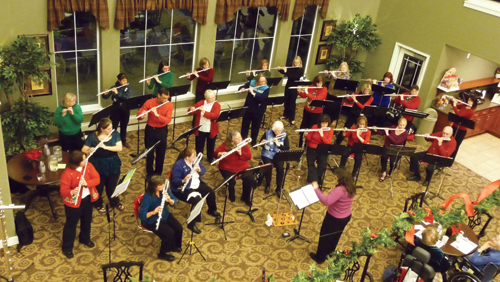
Every year the ensemble plays several December concerts, including one at the Grotto Festival of Lights, held in a stone church at a Catholic retreat that is decked out in millions of lights. The audience is comprised of people who come to tour the beautifully decorated grounds and come into the church to warm up and listen to the music. Because there is a religious affiliation at the venue, they discourage cutesy holiday songs such as Rudolph the Red Nosed Reindeer and Frosty the Snowman. It has always been a challenge to come up with a 45-minute program because most arrangements of traditional Christmas carols and Hanukah songs are so short. I also like to include a more substantial piece of repertoire in our programs to help the group grow musically.
After years of including transcriptions of Handel’s Hallelujah Chorus and For Unto Us a Child is Born, Mozart’s Alleluia from Exultate Jubilate, and movements from the Nutcracker Suite, I decided to broaden our horizons by including transcriptions of pieces that I thought would have broad audience appeal and be musically satisfying for the flute choir to play. Over the past few years, we have included substantial pieces such as Corelli’s Christmas Concerto, Tomas Luis de Victoria’s Four Renaissance Motets, arranged by Phyllis Avidan Louke, Rossini’s La Boutique Fantasque (The Enchanted Toy Shop) arranged by Shaul Ben-Meir, Handel’s Overture and Pastorale from The Messiah, arranged by Robert Maddox, and Respighi’s Ancient Airs and Dances No. 1 arranged by Victoria Jicha. We have also included original music with winter themes such as Secret Language of Snow by Kirk Vogel, Sugar Plums and Mistletoe by Michael Isaacson, A Song of Winter by Phyllis Avidan Louke, and A Winter’s Journey by Lewis Kocher.
Musical style and pacing are important for these holiday performances. I like to program an upbeat joyful piece for the opening. Favorites include Mozart’s Alleluia from Exultate Jubilate and We Three Kings/Carol of the Bells. My favorites for program closers are We Wish You a Merry Christmas, Handel’s Hallelujah Chorus, and Silent Night. I spread out the traditional Christmas carols and Hanukkah songs throughout the program, and place the longest (and least familiar) piece toward the beginning of the program. I also try to sandwich slower pieces between two faster pieces.
I particularly liked the pacing and the stylistic variety of the 2014 program. It interspersed traditional holiday songs throughout the program, with upbeat Christmas carols at the beginning and the end. Several different style periods are represented in this program, from Renaissance to Modern. The major piece, Ancient Airs and Dances No. 1, was enjoyed by the audience, as well as the flute choir. I also liked that the transcriptions came from a variety of mediums: orchestral (Ancient Airs and Dances and Nutcracker Suite), choral (Gloria and There Is No Rose) and piano (Jesu Joy! based on Bach’s Jesu, Joy of Man’s Desiring).
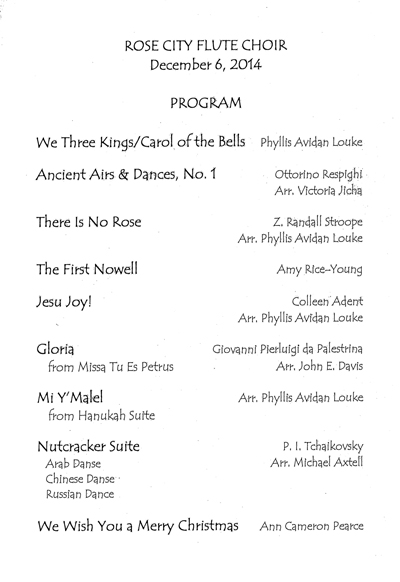
The Flute Academy Flute Choirs Pittsburgh
Director: Wendy Webb Kumer
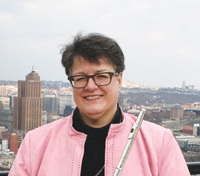 Wendy Webb Kumer has been directing flute choirs since 1980 and is a frequent guest conductor for regional flute festivals and NFA events. Her favorite concerts are those involving huge flute orchestras of all ages and levels performing in 8–12 harmony parts.
Wendy Webb Kumer has been directing flute choirs since 1980 and is a frequent guest conductor for regional flute festivals and NFA events. Her favorite concerts are those involving huge flute orchestras of all ages and levels performing in 8–12 harmony parts.
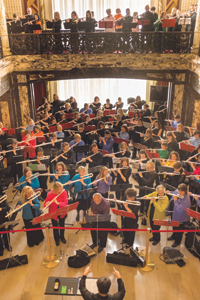 The Flute Academy Flute Choirs include Flute Loops for middle school flutists, grades 4–8 (5-12 members); Flutations for high school students, grades 9-12 (5-12 members); and City Flutes for college students and adults both amateur and professional (25 to 35 members). We hold 4–6 concerts per year and rehearse on Saturdays during the school year, two semesters of 10 weeks each. In addition to concerts at the end of each semester, the ensembles also perform at churches, senior living facilities, Pittsburgh Flute Club events, and special invitations, including concerts at Heinz Hall for and with the Pittsburgh Symphony Orchestra.
The Flute Academy Flute Choirs include Flute Loops for middle school flutists, grades 4–8 (5-12 members); Flutations for high school students, grades 9-12 (5-12 members); and City Flutes for college students and adults both amateur and professional (25 to 35 members). We hold 4–6 concerts per year and rehearse on Saturdays during the school year, two semesters of 10 weeks each. In addition to concerts at the end of each semester, the ensembles also perform at churches, senior living facilities, Pittsburgh Flute Club events, and special invitations, including concerts at Heinz Hall for and with the Pittsburgh Symphony Orchestra.
My favorite program was a concert that presented every possible combination of players, from age 9 to 91, and featured pieces from every era. The total playing time was just over an hour. A spouse of one of the flutists added some texture, rhythm and spice with digital percussion. The Flute Academy’s special commissioned arrangements, Manuel’s Brazilian Aleluia and Steiner’s A Summer Place are my particular favorites. They are available on our YouTube channel: flutecompulsion
Choosing the proper repertoire for flute choir performances is both exciting and daunting. It is important to consider the balance of styles, keys, difficulty, length and so forth, and always keep in mind the total rehearsal time allotted and the ability levels of the players. When you select interesting and varied pieces and place them in a pleasing order, your programs will be more enjoyable for players and audience members.
When selecting pieces for elementary and middle school students, I use short duets, trios, and quartets from collections, introducing many styles from classic transcriptions to folk to pop. Young band flutists are accustomed to playing in unison, so flute choir is often their first opportunity to play in harmony and learn rhythmic independence. Keep the key signatures simple and place pieces in similar keys next to each other. Jumping from one flat to three sharps creates unnecessary trauma and plenty of errors. Use piccolos and low flutes sparingly, but introduce them as young as possible.
High school repertoire can vary greatly. I program everything from double concerti with piano accompaniment, to classic quartets (Reicha, Kuhlau), to the wide range of flute choir repertoire available today. Choosing a mix of difficulty levels (1.5–3.5) boosts interest (technical challenges) and morale (nearly perfect when sightreading). This age group enjoys fast-paced orchestral transcriptions (Flight of the Bumblebee, Hopak, Comedian’s Gallop, Russian Sailor’s Dance, etc.). They also respond to ballads, folk music, and extended techniques. If you choose a long work in multiple movements, bookend it with short, texturally and rhythmically varied pieces to stay balanced. High school flute enthusiasts love the big flutes.
Programming for adult flute choir is enjoyable because their attention spans are longer. They are willing and able to play larger works, but keep styles, lengths, and difficulty levels (2-4) varied. Adults often are shy about trying the low flutes, but if encouraged and coached to get started, often end up purchasing one. Adding a rhythm section (electric or string bass, piano or keyboard, percussion) can increase interest and audience size. From originally composed to classic transcriptions, to folk and pop arrangements, adult flutists are ready to go.
Whatever their age and level, flute choir members enjoy mixing it up, surprising themselves and the audiences with interesting, thoughtful, and diverse programs. Ending with a rousing work will keep everyone humming during the reception and ride home.
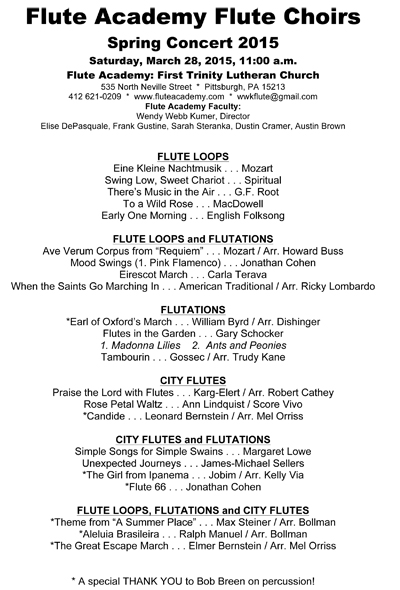
The Ohio State University Flute Troupe, Columbus
Director: Katherine Borst Jones
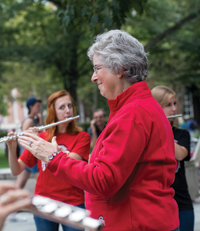 Katherine Borst Jones, professor of flute at The Ohio State University, is the founder of the OSU High School Flute Workshop and the OSU Flute Troupe. She performs with the Pro-Musica Chamber Orchestra, COSMOS, the Columbus Symphony Orchestra and the New Sousa Band. She has served the National Flute Association as President twice, and is the recipient of the 2011 National Service Award.
Katherine Borst Jones, professor of flute at The Ohio State University, is the founder of the OSU High School Flute Workshop and the OSU Flute Troupe. She performs with the Pro-Musica Chamber Orchestra, COSMOS, the Columbus Symphony Orchestra and the New Sousa Band. She has served the National Flute Association as President twice, and is the recipient of the 2011 National Service Award.
The Ohio State University Flute Troupe has 16-22 members from the university flute studio. They perform one full program and several outreach programs each year. Weekly rehearsals are 50 minutes long.
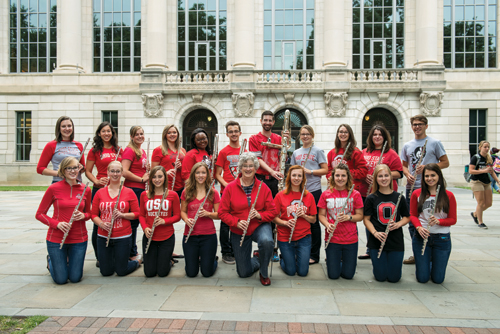
The program below was presented at Bluffton University in a beautiful concert hall for a large audience. We were able to showcase everyone in the flute studio for this full-length performance which included music from the Renaissance to the present day. There were pieces for full flute choir as well as a trio, a septet, and an octet. Included were pieces that the audience might recognize (Bizet, Flight of the Bumblebee, and Londonderry Air) as well as pieces that evoked many different emotions, from sorrow to jubilation. There were pieces originally written for flute choir (Galbraith, Hirose) as well as transcriptions or arrangements (Carillo, Rimsky-Korsakov, Praetorius). I often feature pieces that were written for the OSU Flute Troupe (McIntosh, Duffy, Norman). I make it a practice always to present high-quality music, played well, aiming to provide different colors, moods and emotions for the audience and players.
Flute choir programs should challenge the players as well. On this program the Chris Norman piece gave us a chance to learn traditional style (Irish folk music) including the ornaments. I often include transcriptions of beautiful choral pieces which provide the opportunity to work on pitch and blend in a detailed way.
This program featured a flute trio that had performed many times for events. Within was performed by a septet that mostly rehearsed on their own. Ohio State has recognizable school songs, and we often use Hang on Sloopy as an encore. We were featured on the OSU website with a video of our performance of this piece done for the song’s 50th anniversary. www.youtube.com/watch?v=-rfvzgd57IM
I use programming strategies I learned from Keith Brion that Sousa used with his band. These include featuring major classical pieces, virtuoso solos, operatic arias, section features, pieces by Grainger and others followed by encore marches. A program should include pieces from as many emotions as possible, including patriotic, humorous, sad, happy, jubilant etc. Often the key structure will move up and up for each piece which follows in quick succession. All of this is not possible every time, or even always appropriate, but a fast moving program with much variety of high quality music is essential.
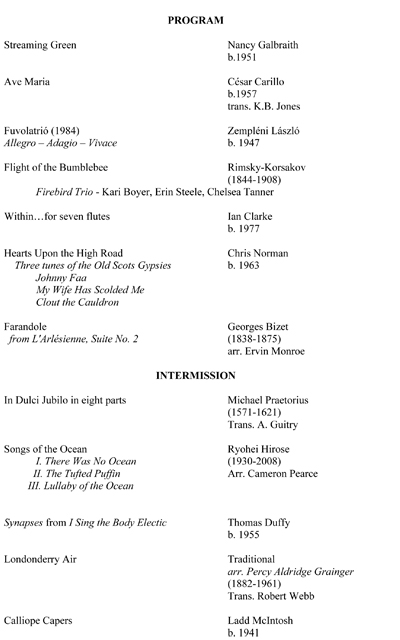
Frost Flute Ensemble University of Miami
Director: Trudy Kane
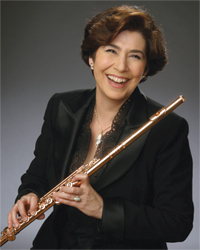 Trudy Kane joined the faculty of the Frost School of Music in 2008 after 32 years as principal flute with the Metropolitan Opera. She is the 2015 recipient of the Phillip Frost Award for excellence in teaching.
Trudy Kane joined the faculty of the Frost School of Music in 2008 after 32 years as principal flute with the Metropolitan Opera. She is the 2015 recipient of the Phillip Frost Award for excellence in teaching.
The Frost Flute Ensemble has 10-12 members and is made up of undergraduate and graduate student flutists. They prepare one program each year that is presented twice. Rehearsals are held once a week during the fall semester, with a couple of extra rehearsals before the concert.
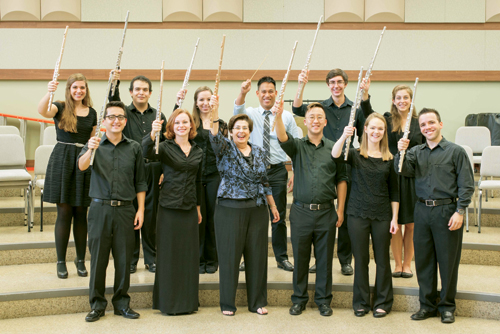
My favorite program took place in November 2014. The music for this program was wonderful to prepare. All four pieces were unique and challenging in their own way. The undergraduate students had a chance to play a leading role in a piece all their own in the lovely arrangement of the Gliere Melody by Erv Monroe. I loved performing with the excellent graduate students in something difficult (Daphnis et Chloé by Ravel), and they more than lived up to the challenge. Performing Daphnis with only five of us, and without a conductor, taught everyone a lot.
The Boheme arrangement brought the style of opera at its best to the students’ attention and was a wonderful way for everyone to learn a new style of making music. Learning the push and pull and naturalness of operatic phrasing (so different from a classical symphony) was a new challenge for everyone. It was the complete second act of La Boheme, including the singers’ parts as well as the orchestra and offstage band. I could not be more proud of the result.
We also played a new piece by our Dean, Shelton Berg, a tradition I have begun of having our faculty write new pieces for us. This piece included a part for improvisation that was written especially for Ernesto Fernandez, and was once again a completely different style of music than the three other pieces.
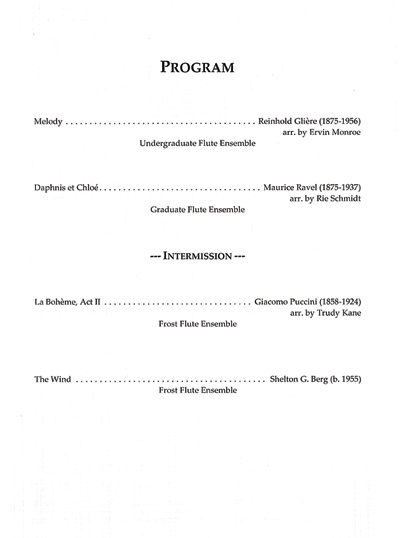
Mercer University Flute Choir, Macon, Georgia
Director: Kelly Via
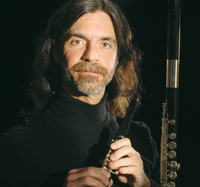 Kelly Via, piccoloist with the Atlanta Ballet Orchestra and Macon Symphony Orchestra, teaches flute at Mercer University, University of North Georgia and the Atlanta Music Academy. He also directs the Mercer University and Atlanta Metro Youth flute choirs and the University of North Georgia Flute Ensemble.
Kelly Via, piccoloist with the Atlanta Ballet Orchestra and Macon Symphony Orchestra, teaches flute at Mercer University, University of North Georgia and the Atlanta Music Academy. He also directs the Mercer University and Atlanta Metro Youth flute choirs and the University of North Georgia Flute Ensemble.
The Mercer University Flute Choir has 14 members and is open to all students as well as community members by audition. This semester 11 of our members are undergraduates, two are recent graduates, and one is the mother of a music major. There are four concerts per year with weekly rehearsals for 30 weeks.
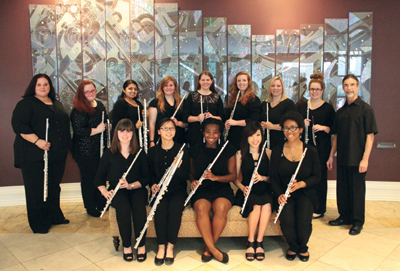
It is wonderful that so many composers are turning their attention to the increasing popularity of the flute choir as a performance medium and the wide range of sonorities and techniques the ensemble provides. The members of the Mercer University Flute Choir especially enjoy playing newer compositions, and they love a challenge.
Our formal concert this past spring is perhaps my favorite to date. The program included all three compositions written to be premiered at the NFA convention in Chicago (2014) by the Windy City Flute Orchestra. Fanfare 42 by John W.N. Palmer offers a majestic opening to a concert with exciting flourish. Ken Kreuzer’s Mystic Wind begins with haunting melodic lines over lush harmonies followed by a lively section with a Celtic feel. Lower Wacker Drive by Peter Senchuk is a jazzy number inspired by the film The Blues Brothers that is always a crowd pleaser.
Steven Tung’s River of Life is perfect for a spring concert with its lovely setting of The Water is Wide and Beckett’s Whisper by Ron Korb provides a beautiful reflective moment in any program. We have become especially fond of Vincenzo Sorrentino’s music and Doppia Dimensione is a fine example of his characteristic soaring melodies and countermelodies, interesting harmonies and driving rhythms. Furry Leaves by Gretchen Morse is a beautifully written lyrical piece with soloist. We were delighted to feature Rachel Hauser Nozny, a graduate from 2004 and now a professional performer and college teacher in Alabama.
Every semester we program at least one big piece and Fire Dance by Valerie Coleman certainly fits the bill. Fire Dance is an exciting and challenging piece for all of the players, and it was an especially big hit with the audience. The piano part is truly optional but it adds great depth and texture to the ensemble.
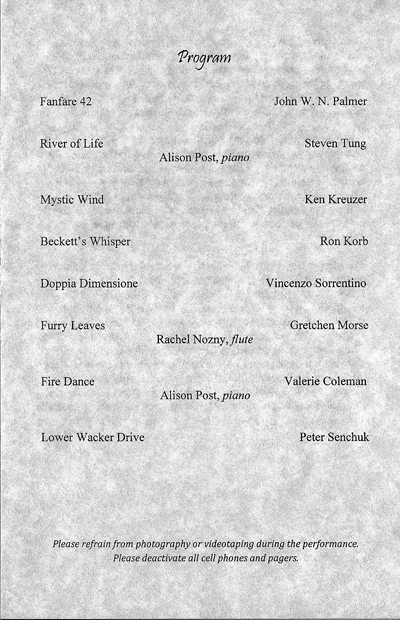
Atlanta Metro Youth Flute Choir
Director: Kelly Via
Kelly Via also directs this youth flute choir in addition to the Mercer University ensemble.
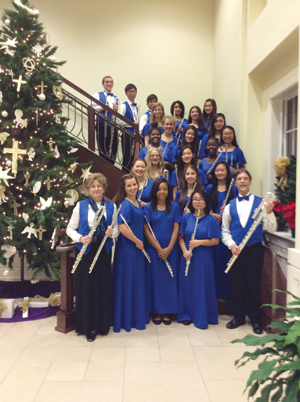 The Atlanta Metro Youth Flute Choir has 23 members and is open to high school and college students by audition. The current membership represents 14 high schools in 8 school districts and one university. They typically perform four or five concerts during the school year. The choir has performed at three NFA Conventions, seven Florida Flute Conventions, three Flute Festivals Mid-South and two GMEA Conferences. Rehearsals are an hour and a half once a week during the school year (approximately 30 rehearsals) for the four or five concerts.
The Atlanta Metro Youth Flute Choir has 23 members and is open to high school and college students by audition. The current membership represents 14 high schools in 8 school districts and one university. They typically perform four or five concerts during the school year. The choir has performed at three NFA Conventions, seven Florida Flute Conventions, three Flute Festivals Mid-South and two GMEA Conferences. Rehearsals are an hour and a half once a week during the school year (approximately 30 rehearsals) for the four or five concerts.
The students in the AMYFC are exceptional players so I plan their programs the same as I would for an adult choir. Our spring concert last year was a favorite of mine. It began with On Wings of the Wind by Bruce R. Smith, a lively concert opener featuring running sixteenth-note patterns that are passed throughout the choir. James Barnes’ Yorkshire Ballad is a standard in concert band repertoire that has been beautifully arranged for flute choir by Arthur Ephross.
One of the most challenging pieces on the program was A Celtic Tapestry by John W.N. Palmer featuring exciting rhythmic outer movements separated by a lush ballad that begins in canon form. Joseph Kreines’ arrangement of Gustav Holst’s lovely Ave Maria with its gently flowing lines is especially effective when performed antiphonally. Streaming Green by Nancy Galbraith offered a striking contrast with driving rhythms, crisp articulations, brilliant melodic lines and a thrilling climax.
Several years ago we started a tradition that gives graduating seniors the chance to choose a favorite piece from their freshman year to add to the final concert of the season. This year the seniors chose The Mayflower Suite by Catherine McMichael, a wonderful three-movement work inspired by the founding of pilgrims’ founding of Plymouth Plantation in 1620. Following the performance of this piece we honored each of the seniors in a special ceremony.
The concert ended with An Afternoon with the Kiddo, a very clever and entertaining work by Greg Lutz. Due to the time factor we only performed the first three movements. However, the students clearly had a blast playing this piece and it was a great way to end the concert.
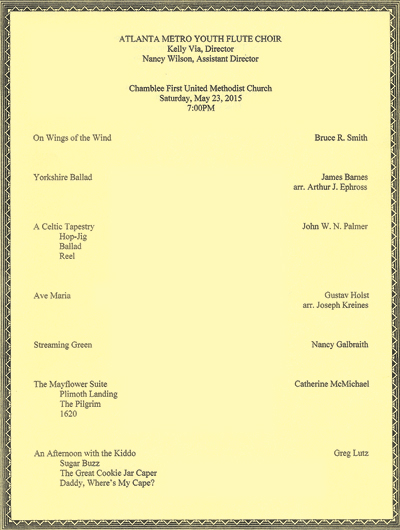
Flute Choir of Atlanta
Director: Kathy Farmer
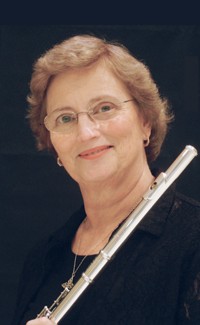 Kathy Farmer has been involved in flute choirs since 1986, when she founded the Atlanta Flute Ensem-ble, which she still conducts. She also directs the Flute Choir of Atlanta as well as being a member of Perimeter Flutes Quartet, the DeKalb Symphony and the Georgia Philhar-monic. Farmer teaches at Georgia Perimeter College, Greater Atlanta Christian School and privately.
Kathy Farmer has been involved in flute choirs since 1986, when she founded the Atlanta Flute Ensem-ble, which she still conducts. She also directs the Flute Choir of Atlanta as well as being a member of Perimeter Flutes Quartet, the DeKalb Symphony and the Georgia Philhar-monic. Farmer teaches at Georgia Perimeter College, Greater Atlanta Christian School and privately.
The Flute Choir of Atlanta has around 20 members and is made up of adult flutists. It is a community ensemble, and many of the members have degrees in music but work in other fields, including as attorneys, legal secretaries, teachers, school principals, biology research and computer communications. The group performs four concerts each year, including a fall concert, Christmas/Hanukah concert, one in early spring and one in early May. We have six or seven rehearsals for the first concert, then two or three for the Christmas concert and five or six for each of the spring performances. When we play at Spoleto or NFA, we have four rehearsals after the regular season ends.
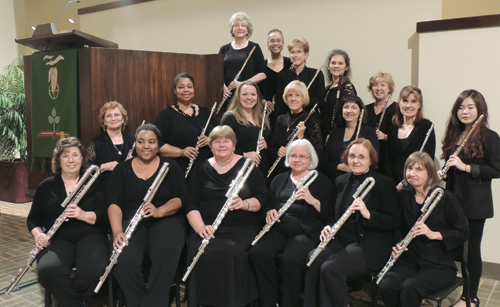
The Winter Wonders concert was a combination of classical music describing winter and well-known Christmas carols. The progression from Dawn Carol, where we stood around the audience, through the descriptive L’Inverno by Vivialdi, to the modern Secret Language of Snow and well-loved carols was interesting to the audience, and the performers loved the variety. The ensemble demonstrated the qualities of big flutes, C flutes and piccolos with songs that were familiar, so the audience was able to really notice the differences between the instruments. One of the members played her own arrangement of Mary Did You Know. It was one of my favorite programs because there was something for everyone in the audience to enjoy.
